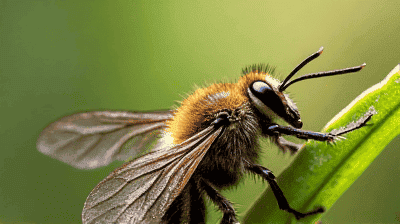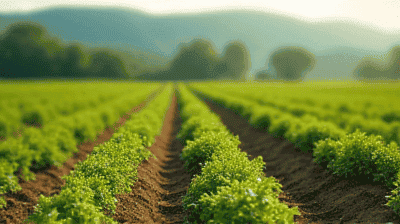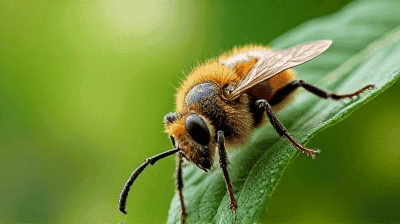
As global awareness of environmental sustainability grows, the demand for organic farming practices has surged. Organic farming not only promotes healthier food choices but also emphasizes methods that nurture the ecosystem, reduce chemical inputs, and enhance biodiversity. One of the primary concerns for farmers—whether organic or conventional—is pest control. While conventional agriculture often relies on synthetic pesticides to manage pest populations, organic farmers utilize a variety of natural strategies to control pests effectively.
Organic farming is rooted in several fundamental principles that differentiate it from conventional agricultural practices:
Soil Health: Organic farmers prioritize maintaining and enhancing soil fertility through practices like crop rotation, cover cropping, and the application of organic matter. Healthy soil supports robust plant growth and improves the ecosystem's resilience to pests and diseases.
Biodiversity: Organic farming encourages biodiversity, promoting a variety of crops and practices that enhance ecosystems. This diversity helps create balanced habitats, which can naturally regulate pest populations.
Natural Inputs: Organic farmers avoid synthetic chemicals and instead use organic inputs, such as compost, natural fertilizers, and organic pest control methods, to nourish plants and manage pests.
Ecological Balance: Organic farming practices are designed to work in harmony with nature. By fostering ecological balance, organic farmers create environments where natural pest control mechanisms can thrive.
Pest management is a critical aspect of agriculture, influencing crop yield, quality, and overall profitability. Pests, including insects, weeds, and diseases, can cause significant damage to crops. As a result, effective pest management strategies are essential for sustaining productivity while minimizing environmental harm.
In conventional agriculture, the reliance on synthetic pesticides has raised concerns about their impact on human health, ecosystems, and biodiversity. In contrast, organic pest control focuses on holistic strategies that utilize natural processes to prevent and manage pest populations while safeguarding the environment.

Cultural practices refer to a variety of farming techniques that create conditions less favorable to pests:
Crop rotation involves alternating the types of crops grown in a specific field from season to season. This method disrupts pest life cycles and reduces the risk of pest outbreaks. For example, rotating plants in the same family (such as tomatoes and potatoes) can help manage pests and diseases that target those species.
Intercropping involves growing two or more crops in close proximity for mutual benefit. Companion planting is a specific form of intercropping where certain plants are combined to repel pests or support each other’s growth. For instance, planting marigolds alongside vegetables can deter nematodes and other pests.
Timing plantings to avoid peak pest populations can also be an effective strategy. Early planting of crops may help farmers escape damage from certain pests that emerge later in the season.
Biological control uses natural predators or pathogens to manage pest populations actively.
Introducing beneficial insects, such as ladybugs, lacewings, and parasitoid wasps, can help control pest populations naturally. These insects feed on aphids, caterpillars, and other harmful pests, providing free and effective pest management.
Beneficial nematodes are microscopic worms that target and kill pest insects in the soil. By introducing these nematodes, organic farmers can suppress certain pest populations without harming beneficial organisms.
Microbial biological control agents, such as bacteria and fungi, can be used to target specific pests. For example, the bacterium Bacillus thuringiensis (Bt) is effective against caterpillars and can be sprayed on crops to reduce pest populations while being harmless to humans and other wildlife.
Physical and mechanical controls involve the use of physical barriers and manual methods to protect crops.
Row covers can be placed over crops to provide a physical barrier against pests. Insect mesh allows light and moisture in while preventing insects from reaching the plants.
For small-scale farms, hand-picking pests such as caterpillars and beetles can be an effective strategy. While labor-intensive, this method is both environmentally friendly and ensures that no chemicals are used.
Using traps, such as sticky traps or pheromone traps, can help monitor and control pest populations. Pheromone traps attract specific pests, indicating their presence and density while removing individuals from the population.
Natural repellents and deterrents involve using plant-based substances or homemade solutions to repel pests from crops.
Essential oils derived from plants, such as peppermint, neem, and citrus, can be applied to crops to deter pests. These natural oils disrupt feeding and mating behaviors in pests.
Homemade sprays made from garlic or chili peppers can act as effective natural repellents. These sprays can be applied to plants and help ward off a range of pests.
Diatomaceous earth is a natural powder made from fossilized algae that can be sprinkled around plants to deter soft-bodied insects like slugs and aphids. It works by damaging their exoskeletons and causing dehydration.
Promoting biodiversity and managing habitats is an integral part of sustainable pest control in organic farming.
Creating habitats that attract beneficial insects and wildlife can contribute significantly to pest management. This can include:
Establishing hedgerows and flower strips that provide food and shelter for beneficial insects.
Planting native species that support local biodiversity and enhance ecological resilience.
Integrating trees and shrubs into agricultural systems (agroforestry) can create diverse ecosystems that provide habitat for beneficial insects and help reduce pest pressure through biological control and competition.
Encouraging pollinator populations not only enhances crop yields but also supports the broader ecosystem. Providing food sources and nesting sites for pollinators can help maintain ecological balance and promote natural pest control.
Organic pest control methods minimize the use of synthetic chemicals, reducing pollution in waterways and protecting non-target species, including beneficial insects, birds, and mammals. By fostering a healthy ecosystem, organic farmers contribute to soil and water conservation.
Many organic pest control practices enhance soil health. For instance, practices like crop rotation and cover cropping increase soil organic matter, improve nutrient cycling, and enhance soil structure, leading to resilient agricultural systems.
Reducing reliance on synthetic pesticides benefits human and animal health. Organic farming minimizes the risk of pesticide exposure for farmers, farmworkers, and consumers, contributing to safer food systems.
Organic pest control methods can lead to sustainable productivity over time. By maintaining ecological balance, organic farms often achieve consistent yields while preserving biodiversity, contributing to long-term food security.

Similar to conventional farming, organic systems can still face pest resistance. To combat this, organic farmers can employ an integrated pest management (IPM) approach, diversifying control methods, and rotating crops to prevent pests from adapting.
Many natural pest control methods, such as hand-picking or maintaining habitat diversity, can be labor-intensive. Farmers may need additional support and training to effectively implement these practices.
Effective pest management in organic systems requires knowledge and experience in understanding pest life cycles, beneficial organisms, and ecological interactions. Ongoing education and research are vital to empower farmers with the skills needed for successful organic pest control.
Advances in technology, such as precision agriculture, offer exciting opportunities for organic pest management. Tools like drones, remote sensing, and data analytics can help farmers monitor pest populations and assess crop health more accurately, allowing for targeted interventions.
Agroecology is an approach that integrates ecological principles with agricultural practices for sustainable food production. By fostering biodiversity, enhancing soil health, and promoting ecosystem services, agroecology offers a framework for holistic pest management.
Investing in research to identify effective organic pest management techniques is essential. Collaborative efforts between universities, research institutions, and organic farmers can lead to the development of innovative solutions tailored to specific pest challenges.

Organic farmers have demonstrated that effective pest control does not require synthetic pesticides. Through a combination of cultural practices, biological control, physical methods, natural repellents, and habitat management, these farmers create resilient ecosystems that enhance biodiversity while producing healthy food.
The movement towards sustainable agriculture highlights the importance of reconnecting with nature and embracing practices that support ecological balance. As consumer demand for organic products continues to grow, the lessons learned from organic pest management can inspire broader changes in food systems, promoting healthier environments for future generations.
By prioritizing natural solutions and fostering diverse, resilient ecosystems, organic farmers are not just controlling pests—they are cultivating a sustainable future for agriculture, society, and the planet.